
December 15, 2008 — Find what you're looking for? Click on the name of a resort below or scroll down for more information on what it's all about.
- Arapahoe Basin
- Aspen Mountain
- Aspen Highlands
- Beaver Creek
- Breckenridge
- Buttermilk
- Ski Cooper
- Copper Mountain
- Crested Butte
- Durango Mountain Resort
- Echo Mountain
- Eldora Mountain Resort
- Keystone
- Loveland
- Monarch Ski and Snowboard Area
- Powderhorn Resort
- Silverton Mountain
- Snowmass
- SolVista at Granby Ranch
- Steamboat
- Sunlight Mountain Resort
- Telluride
- Vail
- Winter Park
- Wolf Creek
Statewide preview
Skiing can be a lot like mining: there are boom years and there are bust years.
The 2007-2008 year was a big-time boom year, with snow coming down in near-record amounts at almost every ski resort in the state. Many resorts had just completed huge, multi-million-dollar upgrades to their services and facilities just as the snow began to fall, and Colorado ski country was looking as good as ever when snow piled high on new lift towers and buildings throughout the mountains.
Big snow doesn’t always mean early snow, however, and ski country was eerily warm and balmy late into November. In the 1960s and 70s, ski resorts traditionally opened in December, when natural snow naturally arrives. These days, however, resorts like Loveland fire up the snowmaking gear as early as September. Two months of sunny days went by in October and November while people around the nation waited, watched, and changed their vacation plans as they determined that no snow was coming in 2007-2008.
Mining for boom-time snow, however, takes patience. Those in the know reveled in one of the best years ever while absent doubters left more room on the slopes for optimists.
There’s no sure-fire way to tell what Mother Nature will do in 2008-2009. Even a below-average snow year, however, blankets the Central Rockies with upwards of 250 inches per year, while average years range from 300 to 400 inches. Somewhere, sometime, there will be a powder gold mine, and it’s up to the intrepid to go find it.
The following guide is meant to help in that search, give brief updates on what’s new, plus general descriptions of what to expect when visiting one of Colorado’s 25 unique and varied ski and snowboard resorts.
Arapahoe Basin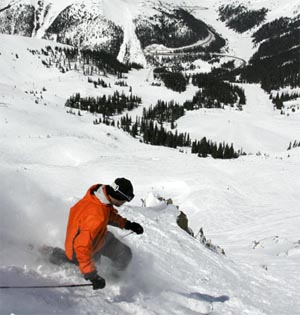
Arapahoe Basin’s Montezuma Bowl became one of the most exciting expansions in the state last year. “A-Basin,” as the area is known, grew by 80 percent with the addition of new chutes, basins, and groomed runs, and it can no longer be thought of as the “little kid on the block” in Summit County’s competitive ski culture.
Long known as a purist paradise, A-Basin is about skiing and riding – not real estate. Families like the uber-casual atmosphere and un-crowded slopes near the base of the mountain, and it’s extreme vistas makes it a special day trip for those spending a week or two at Keystone, Copper Mountain, or Breckenridge, nearby. It’s the expert skiers, snowboarders, and telemarkers, however, who provide the core of A-Basin’s spirit, as some of the most challenging terrain in the state can be found along Montezuma, the East Wall, or bumping down the terrain under the legendary Pallavicini lift.
Fun Fact: A-Basin’s original trail layout was designed by USFS Ranger Wilfred “Slim” David
Average annual snowfall: 350+ inches
Prices: TBD
Skiable Acres: 900
Lifts: 1 quad, 2 triples, 3 doubles, 1 surface
Terrain park: Yes (small)
Season: October to June (depending on weather)
Terrain breakdown: 10 percent beginner, 30 percent intermediate, 37 percent advanced, 23 percent expert
Location: 12 miles east of Silverthorne on Highway 6
Information: www.arapahoebasin.com or (888) ARAPAHOE (272-7246)
Aspen Mountain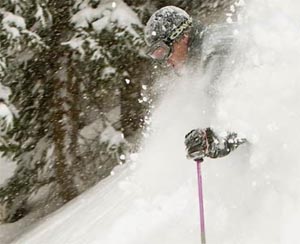
The call to ski this flagship of the Aspen/Snowmass resorts is strong – but more than one intermediate skier has quailed when confronted with Ajax’ steep front face and it’s cramped gondola cabins. The gondola has been overhauled and now features larger cabins and a new base landing. Beginners are still better off heading to nearby Buttermilk, but intermediates should know that Aspen Mountain has a deep pocket of blue slopes (which can’t be seen from the village below) underneath the Ruthie’s Express chairlift. No matter the skill level, however, every snowrider who visits should become acquainted with the rich cannon of stories, personalities, and good riding which permeate this avatar of Colorado skiing.
Fun Fact: Aspen Alpine Guides is now licensed to offer guided tours into backcountry through Aspen Mountain’s backcountry access gates.
Average annual snowfall: 300 inches
Price (Adult all day/half day): TBD
Skiable Acres: 673
Lifts: 1 gondola, 1 high-speed quad, 1 high-speed double, 2 quads, 3 doubles,
Terrain park: No
Season: Nov. 27 to late April 12
Terrain breakdown: 0 percent easiest, 48 percent intermediate, 26 percent advanced, 26 percent expert
Location: Town of Aspen
Information: www.aspensnowmass.com, (970) 925-1220, (800) 308-6935
Aspen Highlands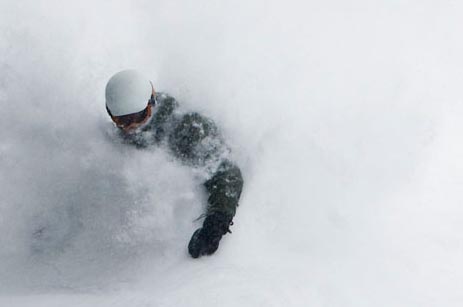
Aspen Highlands was always a local favorite – and then, in 2002, it opened the complete Highland Bowl for the first time, making it legendary in the national skiing and riding scene. Highlands followed up by opening the Deep Temerity lift three seasons ago, and this season will open 18 more acres of terrain in that area (between Hyde Park and Mushroom Chutes) to give experts skiers more terrain to love. Hiking Highlands Bowl – and riding the Highlands in general – may seem like a task reserved for seasoned experts, but take it as a sign of the times that almost all levels of snowriders have the gumption – and the healthy hearts – to climb to the 12,392-foot summit of Highland Bowl and find their way down the stunning slopes. Intermediates will find that the skier’s left of the main mountain is an untouched, uncrowded haven; beginners should take a few runs, hop on the bus and head to Buttermilk.
Fun Fact: Go-Go Gully, in Aspen Highlands Bowl, is the resort’s steepest run at 48 degrees.
Average annual snowfall: 300 inches
Price (Adult all day/half day): TBD
Skiable Acres: 1,028
Lifts: 3 high-speed quads, 2 triples
Terrain park: No
Season: Dec. 13 – April 5
Terrain breakdown: 18 percent easiest, 30 percent more difficult, 16 percent most difficult, 36 percent expert
Location: 3 miles from Aspen
Information: www.aspensnowmass.com, (970) 925-1220, (800) 308-6935
Beaver Creek 
With the addition of Stone Creek two seasons ago and two new gondolas in 2007-2008, there’s now little more Beaver Creek can do to improve its vast and varied terrain. Improving guest services is another matter. The resort seems to be in a constant quest to set new standards in luxury and high-dollar facilities, and as revealed by their slogan, “Not Exactly Roughing It,” there are always efforts being made to increase grooming, ski school, and guest services. The Diamonds in the Rough grooming program, initiated this past season, ensures that one black diamond run will be groomed each night, helping intermediate skiers to make the leap to advanced terrain. Resort officials are hoping that the improvements will help them take the National Ski Area Association’s “Best Overall Customer Service Program” a fourth year in a row. As always, lift tickets purchased here are valid at Vail as well, and it’s worth spending time exploring the less-crowded Beaver Creek during a Vail vacation – or visa-versa.
Fun Fact: Beaver Creek hosts the Talons Challenge on Jan. 29, 2009. About 1,500 people converge at Red Tail Camp to take on 13 runs and 23,722 vertical feet of advanced terrain all in one day.
Average annual snowfall: 310
Price: Prices vary (see website)
Skiable Acres: 1,815
Lifts: 17 (2 Gondolas, 10 high-speed quads, 2 triples, 3 doubles
Terrain park: Yes
Season: Nov. 26-April 12
Terrain breakdown: 19 percent beginner, 43 percent intermediate, 38 percent advanced/expert
Location: 9 miles west of Vail on I-70
Information: www.beavercreek.com, (970) 845-9090, (888) 830-SNOW
Breckenridge 
Industry magazines continually rank Breckenridge’s terrain parks in the top-3 nationwide, yet as snowboarding and twin-tip skiing innovate, so must the parks. Five parks and four halfpipes are strong evidence that Breckenridge still puts jibbers high on the priority list.
Looping through the terrain park is one thing, but skiing a full day throughout Breckenridge’s disparate areas was once a problem. Now, however, the BreckConnect gondola links the Peak 7 base area to coveted intermediate terrain on Peak 7 as well as to the expert above timberline terrain on Peaks 7 and 8, accessed by the T-Bar. The new Sevens Restaurant is also scheduled to open during the winter season.
Fun Fact: Two intermediate trails – Angel’s Rest and Pioneer – will be graced with snowmaking early this season, meaning more than 630 acres of terrain will be served on Peaks 7, 8, and 9 early in the year.
Average annual snowfall: 300 inches
Price: Prices vary (see website)
Skiable Acres: 2,358
Lifts: 30 (2 high-speed sixpacks, 7 high-speed quads, 1 triple, 6 double, 1 gondola, 4 surface, 9 carpets)
Terrain park: Yes (5 parks, 4 pipes)
Season: Nov. 7 – April 19
Terrain breakdown: 14 percent beginner, 31 percent intermediate, 19 percent advanced, 36 percent expert
Location: 104 miles from DIA, on highway 9 (south from exit 203 on I-70)
Information: www.breckenridge.snow.com (800) 789-7669
Buttermilk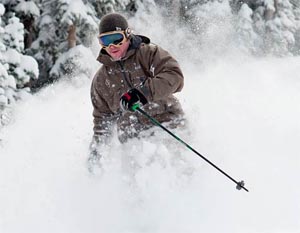
This resort generally has two kinds of clients: beginner skiers and terrain-park riders. The wide-open slopes and casual atmosphere make learning a low-stress process, and the snow is soft, well-groomed, and easy to handle. More than any other resort, this is the place to take your first lesson.
On the other hand, expert and aspiring jibbers from around the nation – and, in fact, the world – make Buttermilk their destination. The two-mile-long terrain park, 30 rails, a permanent slopestyle course, and a 22-foot-high superpipe make Buttermilk a big-air paradise or a learner’s testing grounds, so it’s a good place for young, aspiring X-Gamers to hang out.
Fun Fact: Buttermilk will host the Winter X Games through 2010
Average annual snowfall: 200 inches
Price (Adult all day/half day): TBD
Skiable Acres: 470
Lifts: 9 (2 high-speed quads, 3 doubles, 2 handle tows, 2 ski/snowboard school lifts)
Terrain park: Yes
Season: Dec. 13 – April 5
Terrain breakdown: 35 percent easiest, 39 percent intermediate, 26 percent advanced, 0 percent expert.
Location: 3 miles from Aspen
Information: www.aspensnowmass.com, (970) 925-1220, (800) 308-6935
Ski Cooper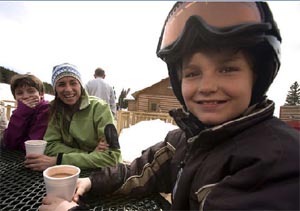
The folks at Ski Cooper aren’t afraid to mention how affordable their resort can be. Relaxed and family-oriented, this is a brown-bag-lunch kind of ski resort where the pressure is low and the elevation is high. Not to be confused with Copper Mountain, nearby, Cooper is located at 10,500 feet above sea level atop Tennessee Pass between Leadville and Red Cliff along the very scenic Highway 24. Although the resort is rustic, it now has an electronic ticketing system – quite a modernization for this small mountain. Early in the season the resort is only open on weekends, but following December 19 it opens daily.
Fun Fact: Cooper’s Chicago Ridge snow cat tours add diversity to the skiing there, but since it’s above treeline be sure to wait for fresh snow and don’t get caught there on a very windy day.
Average annual snowfall: 250 inches
Price: Adult full-day $42
Skiable Acres: 400 lift-served; 2,400 cat-served
Lifts: 1 triple, 1 double, 2 surface
Terrain park: No
Season: November to March
Terrain breakdown: 30 percent beginner, 40 percent intermediate, 30 percent expert
Location: Highway 24, 35 miles south of Vail, 8 miles north of Leadville
Information: www.skicooper.com (719) 486-2277
Copper Mountain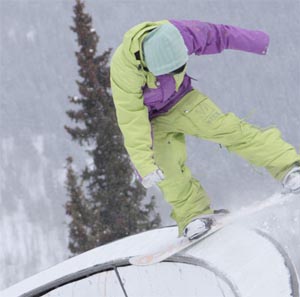
Copper Mountain recently concluded a seven-year process working with the U.S. Forest Service to gain approval of their Environmental Impact Statement – which means many of their planned improvements will begin to take shape in the coming years.
In the meantime, expanded glade skiing gave the resort more skiing in 2007-1008, and its collection of terrain parks, crowned by a massive halfpipe, is also becoming one of the most respected in the nation. Copper’s terrain is easy to find and its maps easy to decipher, and it has long been heralded as one of the best-planned and laid-out mountains in the country. The eastern slopes of the mountain are the steepest and most difficult, the western slopes the easiest, and the terrain in the middle is intermediate. A relatively new base area, completed several years ago, has come to life and added vitality to the resort’s après ski and nightlife scenes.
Fun Fact: Copper Mountain offers paragliding from the top of the mountain throughout the winter.
Average annual snowfall: 282 inches
Price: TBD
Skiable Acres: 2,450
Lifts: 22 (1 high-speed sextuple, 4 high-speed quad, 5 triple, 5 double, 2 surface, 4 conveyer, 1 tubing zone lift)
Terrain park: Yes
Season: November 14 to April 19
Terrain breakdown: 21 percent beginner, 25 percent intermediate, 36 percent advanced, 18 percent expert
Location: 40 minutes west of Denver on I-70
Information: www.coppercolorado.com (800) 458-8386
Crested Butte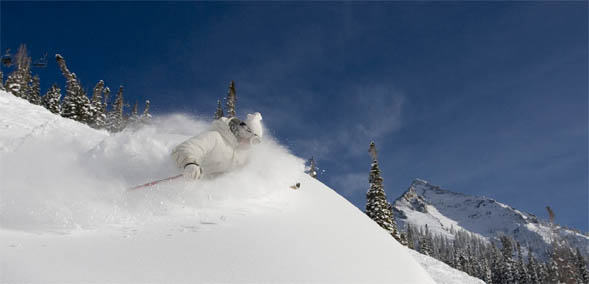
This year’s big change at Crested Butte comes with the upgraded Treasury Center base-area building and the “Camp CB” kids’ ski school – but these are only a few of many improvements ongoing as Crested Butte continues a multi-year improvement plan under new ownership. The resort was long known as a hard-core skiers hang-out, and bred the extreme scene’s most prolific generation of superstars with Seth Morrison and Matchstick productions. Crested Butte’s other side is now burgeoning. A series of luxury homes and hotels are arriving, and a new stable of snow cats provide many more groomed runs. While the corduroy is pretty good all year, the extreme terrain gets better as the year goes on as ample annual snowfall covers the steep’s many rocks and boulders. Experts aren’t completely left out of the improvement game in 2008-2009: this year will feature new terrain in Teocalli Bowl to an area known as Teo II.
Fun Fact: Crested Butte offers free skiing Nov. 25 to Dec. 15, 2007.
Average annual snowfall: 250 inches
Price: Adult full-day $82
Skiable Acres: 1,167
Lifts: 16
Terrain park: Yes
Season: Nov. 26 – April 5
Terrain breakdown: 23 percent beginner, 57 percent intermediate, 20 percent expert
Location: 4 hours from Denver, north of Gunnison on highway 135
Information: www.skicb.com, (800) 810-7669
Purgatory at Durango Mountain Resort 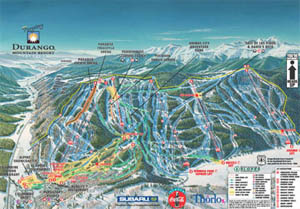
Purgatory Mountain is highlighting its family-oriented feeling heading into the 2008-2009 season, with a focus in their two terrain parks, a children’s play park, and a NASTAR racing course. The resort continues to benefit from higher snowmaking efficiency which allows terrain like the “Backside,” to be opened earlier in the season – and to stay open later into spring. Regardless, it’s Durango’s natural snow which may be the best in Colorado. Its geography is perhaps its best asset: Purgatory Mountain rises up out of the red desert with a kind of cinematic grandeur, but the metrological effect of the mountain’s proximity to such dry country makes its snow improbably fluffy and light. The Resort, which has scenery fitting for an Old West drama, also prides itself on sunny days and relatively warm weather, which may be why the resort seems to have caught on with skiers who come from around the Southwest.
Fun Fact: Nearby Mesa Verde Park features ancient cliff dwellings once inhabited by Anasazi Native Americans.
Average annual snowfall: 260 inches
Price: $60 for adults
Skiable Acres: 1,200
Lifts: 9
Terrain park: Yes (2)
Season: Nov. 27 – April 5
Terrain breakdown: 23 percent beginner, 51 percent intermediate, 26 percent advanced/expert
Location: Durango, Colo.
Information: www.durangomountainresort.com, (800) 525-0892
Echo Mountain 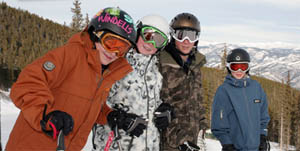
Music pumps, lights shine, and the stunt ditch awaits. Like a skate park blanketed in winter white, Echo Mountain carries the same atmosphere and social energy of a downtown skate park, but instead of wheels, Echo Mountain has rails, kickers, pipes and pumped up jibbers. With proximity to the Front Range (35 miles from Denver), and lights on until 9 p.m., it’s an option even on the weekdays after school. For knuckle-draggers and park rats who refuse to roll without their favorite hoodie, it’s da bomb.
Fun Fact: Echo park is open at night Wednesday through Saturday, under the lights.
Average annual snowfall: 260 inches
Price: $129 season pass
Skiable Acres: 50
Lifts: 1
Terrain park: Yes
Season: Dec. 1 to March 30
Terrain breakdown: All terrain park
Location: 35 miles west of Denver
Information: www.echomountainpark.com, (303) 352-7347
Eldora Mountain Resort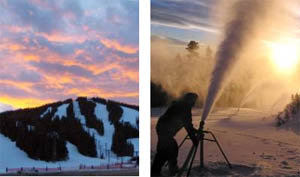
There is an East Coast feel to this Front Range resort. It can’t boast the largest annual snowfall or the most skiable acres - its strength is proximity to the Front Range and a very social mix of riders. Still, the resort will sometimes capture more from a storm cycle than the other resorts, and although it is close to the Front Range it still has a high-altitude base at 9,200 feet above sea level. Located 21 miles west of Boulder, Eldora is the day-trip fix for beginning and intermediate Front Range riders. A few quick tree routes and a stop by the terrain park can keep adventuresome riders busy, and a relaxed, snow-loving atmosphere prevails among the college students and commuters who frequent the resort.
Fun Fact: Eldora’s new slogan: “Friends Don’t Let Friends Drive I-70”
Average annual snowfall: 300 inches
Prices: Adult full-day $59
Skiable Acres: 680
Lifts: 12 (2 quad 2 triple, 4 double, 4 surface)
Terrain park: Yes
Season: Mid-November to mid-April
Terrain breakdown: 20 percent beginner, 50 percent intermediate, 30 percent advanced
Location: 21 miles west of Boulder on highway 119, or 47 miles northwest from Denver on Highway 72
Information: www.eldora.com (303) 440-8700
Keystone
A new gondola for the 2008-2009 season makes navigating Keystone much easier – day or night. The eight-passenger, top-of-the-line gondola will follow the same alignment as the current six-passenger gondola, but will find its base in the oh-so-convenient heart of River Run Village.
Once atop Keystone Mountain, gondola riders will have the option of skiing back to the base, jumping into the tubing hill, or heading out toward North Peak on the Outpost Gondola. This is where experts can sink their teeth into Keystone’s upper reaches. A hike up the ridge to the top of Erickson Bowl or Bergman Bowl is usually possible from the top of North Peak, but Outback Bowl is a must for any glade skier. For those who aren’t quite so hard core, the lower reaches of North Peak are generally sunny and relaxed.
Fun Fact: The popular Betty Fest Alpine Ski Women’s Weekend will be expanding in the 2008-2009 season and a Nordic Fest program will be added.
Average annual snowfall: 230
Price: Prices vary (see website)
Skiable Acres: 3,148
Lifts: 20 (2 gondolas, 1 high-speed sixpack, 5 high-speed quad)
Terrain park: Yes (A51 terrain park)
Season: Nov. 7 – April 12
Terrain breakdown: 12 percent beginner, 34 percent intermediate, 54 percent advanced/expert
Location: 75 miles west of Denver on Highway six, south of I-70
Information: www.keystone.snow.com (877) 753-9786
Loveland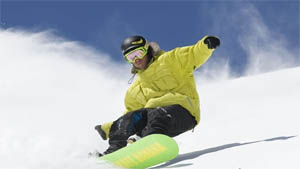
Drivers heading westbound on I-70 see Loveland Ski Area appear before them like a billboard for Colorado skiing as they make their way toward Eisenhower Tunnel. The resort makes for a great park-and-ski day trip because it’s easy to get to and easy to navigate. Its high-altitude location on the Continental Divide makes it one of the first mountains to open and one of the last to close each year. Most of the good riding at Loveland is wide-open, intermediate terrain, yet several pockets of very steep, expert terrain can keep an expert skier busy through the day. Beginners have an entire hill to themselves, where chairs 7 and 3 make for a relaxing, gentle day away from speedy experts.
Fun Fact: Parking is free at Loveland
Average annual snowfall: 400 inches
Price: TBD
Skiable Acres: 1,365
Lifts: 7
Terrain park: Yes (no halfpipe)
Season: Mid-October to mid-May
Terrain breakdown: 13 percent beginner, 41 percent intermediate, 46 percent advanced/expert
Location: Eisenhower Tunnel, 45 min west of Denver on I-70
Information: www.skiloveland.com (800) 225-5683
Monarch Ski and Snowboard Area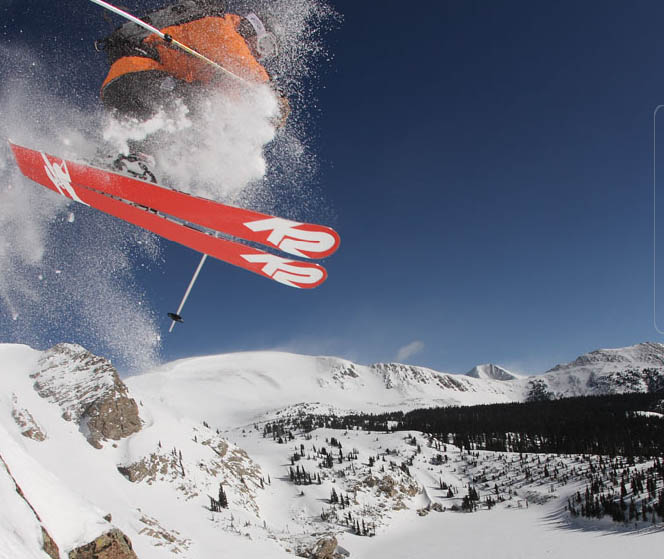
Monarch will roll out a new ski school and rental center, a new kids terrain park, and improved signage around the mountain among other improvements in 2008-2009.
The resort has done well to keep up with other Colorado resorts, but it’s still one of the state’s best kept secrets. College students from Gunnison like it for the ample steeps and nearby backcountry tree skiing which dumps out onto Highway 50 for an easy shuttle. The in-bounds skiing is easy to manage because of the area’s simple design – families or groups with a wide range of skill level can split up at the top, choose their own terrain, and meet at the bottom with little trouble finding their way. Without snowmaking, Monarch doesn’t have the ability to make a halfpipe or sizeable terrain park, but some say its all-natural snow is an advantage. Lodging is in Buena Vista, Salida, or Poncha Springs, all a half-hour drive (or more) away from the slopes.
Fun Fact: Snowcat skiers will enjoy 200 additional acres of terrain this season
Average annual snowfall: 350 inches
Price: Adult full-day $54
Skiable Acres: 800 acres
Lifts: 5 (1 quad, 4 doubles)
Terrain park: Yes
Season: Nov. 26 to April 12
Terrain breakdown: 14 percent beginner, 28 percent intermediate, 27 percent advanced, 31 percent expert
Location: 18 miles west of Salida on highway 50
Information: www.skimonarch.com, (888) 996-7669
Powderhorn Resort
The setting at Powderhorn is as gentle as the slopes which spread along the mountain’s frontside. Surrounded by mesas and buttes, Powderhorn has a kind of “high-plains drifter” feel, which it has had since skiing began on Grand Mesa in the 1940s. Once the resort opened, in 1966, it instantly became a getaway spot for Western Slope residents. The air makes for dry, easy-to-ride powder, warm weather and unique views. Its focus is families, beginner and intermediate skiers, offers 600 acres of groomed skiing, and it prides itself on a laid-back atmosphere and reasonable ticket prices.
Fun Fact: Powderhorn makes up for a lack of vertical with two quality terrain parks.
Average annual snowfall: 250 inches
Price: Adult full-day $53
Skiable Acres: 1,600
Lifts: 4 (1 quad, 2 doubles, 1 surface)
Terrain parks: 2
Season: Early December to early April
Terrain breakdown: 20 percent beginner, 50 percent intermediate, 15 percent advanced, 15 percent expert
Location: Grand Mesa, 35 miles east of Grand Junction on highway 65
Information: www.powderhorn.com, (970) 268-5700
Silverton Mountain

The accolades for this pioneering resort continue to come. It was rated No. 1 in steeps and No. 1 in powder in the USA by Skiing Magazine in 2003-2004, Top Ski Resort by 5280 Magazine, and the “Top Extreme Ski Experience” by the Rocky Mountain News.
With Silverton Mountain, the old saying usually holds true: “If you have to ask, you’ll never know.” Colorado’s newest resort is expert-only, and has created quite a buzz over the past few years in such circles. It is a one-lift, backcountry experience for riders dedicated to powder. If conditions are right, the available terrain can get as scary – and hairy – as a rider can handle.
Fun Fact: Silverton also works in conjunction with El Diablo Snow Cat Tours
Average annual snowfall: 400+
Price: $49 (unguided) $99-129 (guided)
Skiable Acres: 1819 (depends on what you can handle)
Lifts: 1
Terrain park: No
Season: Unguided Nov. 29-Jan 11 and April 3 – April 19. Guided Only skiing Jan. 15-March 29.
Terrain breakdown: 100 percent expert
Location: Silverton, in southwestern Colorado
Information: www.silvertonmountain.com
Snowmass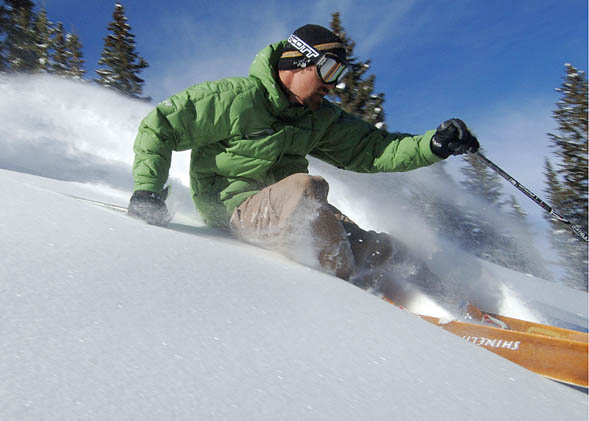
The term Sheer Bliss used to be oxymoronic at Snowmass, where the old, creaky, two-seater Sheer Bliss lift made for an agonizingly slow option for reaching the Big Burn area. The Aspen Skiing Company has given a lot of love to Snowmass in recent years, including the creation of a $17 million “Treehouse” adventure center for children in 2007-2008 and a revamped base area, but skiers will be starry-eyed over the $7 million Sheer Bliss capital improvement, which replaces the old lift with a new high-speed quad which serves the 700 acres in the Big Burn area in just over nine minutes. A $9 million “Sam’s Smokehouse” restaurant is also ready for this season atop the Village Express six-pack lift.
Snowmass Mountain itself is quite large and equally as varied. It has beginning and intermediate terrain for cruisers, bumpers, and tricksters. Advanced and expert skiers bypass the mellow ride for the quick hike to the Cirque, where Snowmass provides terrain to match Highlands Bowl nearby. Snowmass is relatively uncrowded, with an average of two people per acre.
Fun Fact: Snowmass hosts, on average, two people per acre
Average annual snowfall: 300 inches
Price (Adult all day/half day): TBD
Skiable Acres: 3,132
Lifts: 20
Terrain park: Yes
Season: Nov. 27 – April 12
Terrain breakdown: 6 percent easiest, 50 percent intermediate, 12 percent most difficult, 32 percent expert
Location: 9 miles from Aspen
Information: www.aspensnowmass.com, (970) 925-1220, (800) 308-6935
SolVista at Granby Ranch
Skiing is just one part of the scene at Solvista, where nearby hot springs, spa treatments, and other accoutrements are part of the attraction. The gentle slopes attract families and easy-going skiers to an area tucked into the timber 15 miles from Winter Park. Its five lifts service two connected mountains. The east mountain is beginner and intermediate, and the west mountain is slightly more difficult. SolVista may have some of the best deals around for beginner skiers looking for an instruction/ski package.
Fun Fact: SolVista is part of a larger resort, known for its golf, called Granby Ranch.
Average annual snowfall: 220
Price (Adult all day/half day): TBD
Skiable Acres: 406
Lifts: 6
Terrain park: No
Season: Dec. 19 to March 30
Terrain breakdown: 30 percent beginner, 50 percent intermediate, 20 percent advanced
Location: 15 miles north of Winter Park, 2 miles south of Granby
Information: (888) 283-7458
Steamboat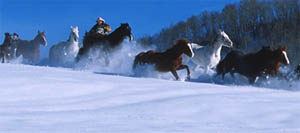
Cowboy hats manage to find their way into almost every page of promotional material for this resort, but there’s good reason: Steamboat is one of the few resorts that’s managed to maintain a down-to-earth, ranch-life feel even as it has grown into one of Colorado’s most modern resorts.
Steamboat is still flowing with pride over its $16 million in improvements made in 2007-2008, which included the new six-passenger Christie Peak Express chairlift, re-grade of the Headwall terrain, significant snowmaking improvements and expansion of the Meadows parking facility. Unlike some other Colorado resorts, Steamboat is far away from any major highway or metropolitan district, which makes it a bit harder to get to but very peaceful once there.
As Colorado’s second-largest ski area Steamboat can boast ample amounts of almost all kinds of terrain, including a 500-foot long super-pipe. Steamboat also tends to have different weather patterns than the I-70 corridor slopes, so look to Steamboat for snow when the rest of Colorado is ailing.
Fun Fact: Olympic silver medalist Billy Kidd (1964) is Director of Skiing and a spokesperson for Steamboat
Average annual snowfall: 335
Price: TBD
Skiable Acres: 2,965
Lifts: 25
Terrain park: Yes
Season: Nov. 27 - April 12
Terrain breakdown: 14 percent beginner, 42 percent intermediate, 44 percent advanced
Location: 160 miles northwest of Denver, on highway 40 west of Kremmling
Information: www.steamboat.com 970-879-6111
Sunlight Mountain Resort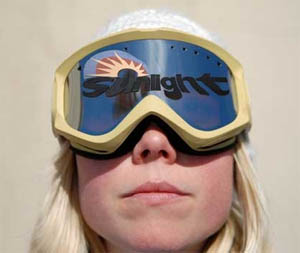
If it were located almost anywhere else in the country, Sunlight would be the top resort for miles around. A 52-degree slope on the Extreme East Ridge makes it one of the most challenging mountains in the state, yet it’s still most popular with low-pressure beginners and intermediates who prefer its atmosphere to the ritz and glitz of nearby Aspen. It’s proximity to Aspen’s four mountains has given the mountain its biggest challenge (to withstand comparison to Aspen’s legendary hills) yet also its biggest asset (The Roaring Fork Valley’s skiers and riders often choose Sunlight as an alternative to Aspen’s spotlight). Intermediates might find it a good proxy for Utopia, as more than half of the mountain is intermediate terrain. Tree skiers, too, will not be disappointed with Sunlight’s in-between spaces – so long as ample snow has fallen. None should be disappointed with Sunlight’s affordability, especially compared with its neighbors down the road.
Fun Fact: Sunlight is named after a once-thriving coal mining town that disappeared in the early 1900s
Average annual snowfall: 250 inches
Price: TBD
Skiable Acres: 470
Lifts: 4 (1 triple, 2 double, 1 surface)
Terrain park: Yes
Season: December to April
Terrain breakdown: 20 percent beginner, 55 percent intermediate, 20 percent advanced, five percent expert
Location: Glenwood Springs
Information: www.sunlightmtn.com, (800) 445-7931
Telluride
Do not visit Telluride without a stroll through its old town, where 100-year-old Colorado history is perhaps more visible than anywhere else in the state. It just so happens that one of the great ski resorts of the nation is also nearby, rising precipitously from the heart of the old town.
Towering peaks shade this box-canyon resort through most of the short winter days, so riding the excellent gondola system to the top of the hill is a good way to get into the Colorado sunshine. From there, experts will want to sample the new Revelation Bowl set to open during the 2008-2009 season, which will offer 400 new acres of classic Telluride-style terrain. The Revelation Bowl terrain has long tempted riders who could look, but not touch, the pristine black-diamond terrain. Even the boldest of skiers stayed away in former days, as the bowl ends in a series of massive cliffs. With a new lift the backside of Telluride is finally open to everyday skiers.
While experts swap stories of stashes lost and found in Prospect Bowl and Revelation Bowl, beginners can revel in the accessibility of chairs 10 and 11. Intermediates can cruise the blues and bumps under chairs 4 and 5, advances riders can hit chairs 6, 9, and 14.
Fun Fact: Allred’s on-mountain restaurant, located at 10,551 feet above sea level, is routinely described as among the best in the state
Average annual snowfall: 309
Price (Adult all day/half day): TBD
Skiable Acres: 2,000+
Lifts: 18 (2 high-speed gondolas, 7 high-speed quad, 1 fixed quad, 2 triple, 2 double, 2 surface, 2 magic carpet)
Terrain park: Yes
Season: Nov. 27 – April 5
Terrain breakdown: 21 percent beginner, 32 percent intermediate, 47 percent advanced/expert
Location: 65 miles from Montrose on highway 145, or 71 miles north of Cortez
Information: www.tellurideskiresort.com or (970) 728-6900 or (800) 778-8581
Vail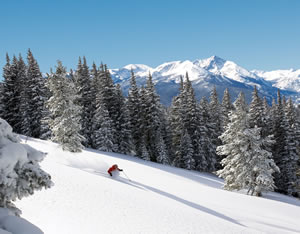
The Town of Vail is nearing the close of its three-year, multi-billion-dollar renewal, and the entire Village is shimmering like a brand-new Christmas gift. The streets, lodges, and shops nearly dripping with opulence, yet Vail is also entering its most egalitarian, affordable year perhaps in its history.
The $579 Epic Pass season pass will bring new vitality to the town, say supporters, as it helps open up Vail’s pearly gates (and tremendous terrain) to almost all comers. Consistently ranked as one of the top one or two ski mountains in North America, Vail is huge, varied, well-groomed, well-tended, and formerly very expensive.
Those who opted for more affordable resorts in the past may want to take a few days (or weeks) to get acquainted with Vail’s 93 different runs, more than 5,000 acres, and every kind of terrain (except, arguably, good sustained steeps).
With all this ahead, the key to a good day in Vail is navigation and planning. Weekend crowds can fill the main lift lines but leave others empty, and snow conditions can be completely different on the southern exposures than on the northern exposures. Good snow can always be found in patches, in the trees, or on the groomers, which are listed at the three main base areas (Golden Peak, Vail Village, and Lionshead).
Fun Fact: Vail is removing dead and dying beetle-kill from portions of the mountain as a fire and safety precaution – but a positive by-product will be a cleaner, healthier-looking forest on Vail’s frontside
Average annual snowfall: 346
Price: Prices vary (see website)
Skiable Acres: 5,289
Lifts: 34
Terrain park: Yes
Season: Nov. 21 – April 19
Lifts: 31 (1 gondola, 16 high-speed quad, 1 quad, 3 triple, 1 double, 3 surface, 6 carpet)
Terrain breakdown: 18 percent beginner, 29 percent intermediate, 53 percent advanced/expert
Location: 100 miles west of Denver on I-70
Information: www.vail.snow.com/winter, www.realvail.com, (970) 476-5601
Winter Park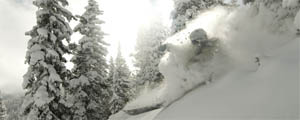
Winter Park has poured more than $40 million into on-mountain enhancements over the past four years, including four new chairlifts. Last year’s skiers benefited from a new six-pack chairlift which made for simpler access to 1,123 acres, including Vasquez Cirque, Parsenn Bowl and the Eagle Wind Trails and 100 acres of new intermediate and advanced terrain.
Winter Park is actually a connected group of five areas: Winter Park, Mary Jane, Parsenn Bowl, Vasquez Cirque and Vasquez Ridge. The bump skiing at Winter Park has long been heralded as the best in the state, and those searching for bumping bliss will want to visit Mary Jane and Vasquez Ridge. Intermediates are at home at Vasquez Cirque, parts of Mary Jane and Winter Park. Beginners can explore the gentle slopes at Winter Park.
Fun Fact: Winter Park is home to the National Sports Center for the Disabled
Average annual snowfall: 359
Price: TBD
Skiable Acres: 3,060
Lifts: 25 (1 high-speed sextuple, 7 high-speed quad, 4 triple, 7 double, 3 surface, 3 magic carpet)
Terrain park: Yes
Season: Nov. – April
Terrain breakdown: 9 percent beginner, 21 percent intermediate, 13 percent advanced, 54 percent expert, 3 percent extreme
Location: 67 miles northwest of Denver
Information: www.skiwinterpark.com (303) 892-0961
Wolf Creek
The amount of snow seen at this ski area borders on absurdity. Ski lodges, lift shacks, and base-area restaurants often surrounded by massive snowbanks, and its hike-to terrain is at the top of the list for early-season powder skiers looking for their first face-shots of the year. At 10,300 feet above sea level on a high pass near Pagosa Springs, nearly 200 miles from the nearest major airport, Wolf Creek can be hard to get to – but riders who make it have the place to themselves. A hike to the top of the ridge is the best spot to get expert or advanced turns, while the base of the mountain remains a casual corner in Colorado skiing. Beginners can spend the day on the Nova Chair for a cut rate.
Fun Fact: Wolf Creek garnered 492 inches during the 2007-2008 season
Average annual snowfall: 465 inches
Price: TBD
Skiable Acres: 1,600
Lifts: 7 (1 high-speed quad, 1 double, 2 triple, 1 quad, 1 high-speed poma, 1 magic carpet
Terrain park: No
Season: Early Nov. to early April
Terrain breakdown: 20 percent beginner; 35 percent intermediate; 25 percent advanced; 20 percent expert
Location: San Juan/Rio Grande National Forest, Highway 160, Wolf Creek Pass, Between Pagosa Springs and South Fork, 75 miles east of Durango, 65 miles west of Alamosa
Information: www.wolfcreekski.com (970) 264-5639
![]() 2 Comments on "Planning a Colorado ski vacation? Read the 2008-2009 Colorado ski resort guide and preview"
2 Comments on "Planning a Colorado ski vacation? Read the 2008-2009 Colorado ski resort guide and preview"
Paul D. — December 16, 2008
Check out the conditions before you make your trip. Here's the link to OnTheSnow.com's Colorado page: http://www.onthesnow.com/colorado/skireport.html
Misty — June 14, 2009
I am trying to plan my honeymoon and we are wanting to leave somewhere between october 10th and return 18 of october. We want a fun filled trip with skiing is there anything for that time of the year? Please help!!!










